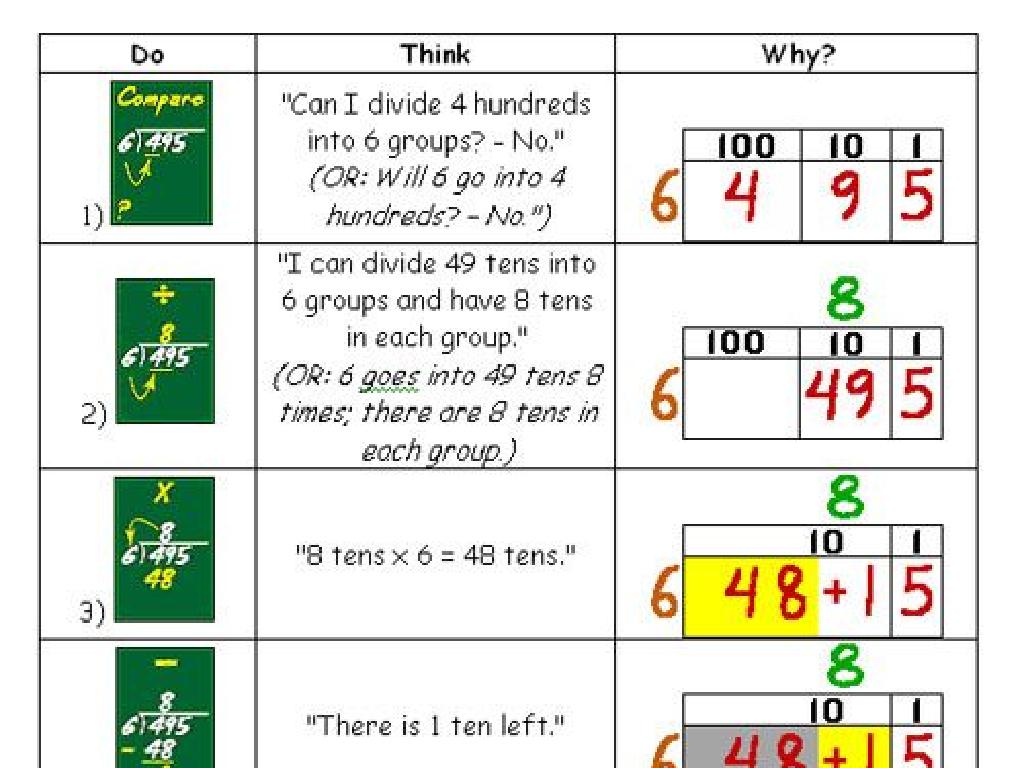Reproductive System And Pregnancy
Subject: Science
Grade: High school
Topic: Health & Medicine
Please LOG IN to download the presentation. Access is available to registered users only.
View More Content
Introduction to Human Reproduction
– Fundamentals of human reproduction
– The process by which humans create offspring.
– Significance of reproductive health
– Maintaining reproductive health is vital for overall well-being and successful reproduction.
– Male reproductive system
– Includes organs like testes which produce sperm and hormones.
– Female reproductive system
– Comprises ovaries, fallopian tubes, and more, responsible for egg production and nurturing a fetus.
|
This slide introduces the complex topic of human reproduction, which is essential for the survival of our species. Begin with a basic explanation of how reproduction works in humans, emphasizing the biological processes involved in creating new life. Highlight the importance of reproductive health, including the prevention of diseases and conditions that can affect reproductive capabilities. Provide an overview of the male reproductive system, discussing the role of testes in sperm and hormone production. Then, describe the female reproductive system, detailing the organs involved in egg production and the development of a fetus. This foundational knowledge sets the stage for a deeper dive into the intricacies of human reproduction and pregnancy in subsequent lessons.
Exploring the Male Reproductive System
– Anatomy of male reproductive system
– Includes testes, vas deferens, urethra, and more
– Functions of key components
– Testes produce sperm, hormones; urethra serves as a conduit
– Spermatogenesis process
– The development of sperm cells within the testes
– Role in reproduction
– Sperm production is crucial for fertilization and genetic diversity
|
This slide aims to provide a comprehensive overview of the male reproductive system, its anatomy, and its functions. Highlight the key organs involved, such as the testes, which are responsible for the production of sperm and hormones like testosterone. Explain the process of spermatogenesis, where sperm cells are developed and matured within the testes. Emphasize the importance of each component in the overall process of reproduction. Discuss the role of sperm in fertilization and how it contributes to genetic diversity. Encourage students to ask questions and think about how each part of the system is interconnected and vital for the reproductive process.
Exploring the Female Reproductive System
– Anatomy of female reproductive system
– Includes ovaries, fallopian tubes, uterus, and vagina
– Phases of the menstrual cycle
– Menstrual, follicular, ovulation, and luteal phases
– Hormonal changes in menstruation
– Estrogen and progesterone regulate the cycle
– Understanding oogenesis
– Oogenesis is the creation of an ovum (egg cell)
|
This slide aims to provide a comprehensive overview of the female reproductive system, crucial for understanding human biology and reproductive health. Begin with the anatomy, highlighting each part’s role and structure. Then, explain the menstrual cycle’s phases, emphasizing the hormonal regulation involved. Discuss oogenesis, the process by which egg cells are formed, and its significance in reproduction. Use diagrams to illustrate the anatomy and the cycle phases. Encourage students to ask questions and think about how each component fits into the larger picture of reproductive health.
The Process of Fertilization
– Sperm’s journey to the egg
– Sperm travels through the female reproductive system to reach the egg.
– Conception: The fusion moment
– When a sperm cell and an egg cell unite, it marks the beginning of pregnancy.
– Genetic implications
– The combination of DNA from both parents influences the baby’s genetic traits.
– Fertilization outcomes
|
This slide aims to explain the process of fertilization in human reproduction. It begins with the journey of sperm, highlighting the arduous path sperm must navigate to reach the egg. The moment of conception is when a single sperm successfully penetrates the egg, initiating the development of a new individual. The genetic implications are significant because the unique combination of parental genes will determine the inherited characteristics of the offspring. Understanding fertilization is crucial for comprehending how genetic traits are passed on and the very start of pregnancy. Encourage students to think about the complexity of this process and its importance in the continuation of life.
Pregnancy and Development: Understanding the Stages
– Trimesters of pregnancy
– First, second, and third trimesters, each with unique developmental milestones.
– Embryonic vs. fetal development
– From a single cell to a complex organism, the journey of growth inside the womb.
– Importance of maternal health
– A mother’s health directly influences the baby’s development and well-being.
– Prenatal care essentials
– Regular check-ups, balanced nutrition, and avoiding harmful substances are crucial.
|
This slide aims to educate high school students on the critical stages of pregnancy and the importance of prenatal care. The trimesters are divided into three stages, each marked by specific developmental progress in the embryo or fetus. Students should understand the transformation from a fertilized egg into a fully formed baby, and the role of maternal health in this process. Emphasize the significance of prenatal care, including proper nutrition, avoidance of alcohol and drugs, and regular medical check-ups to ensure the health of both mother and child. Use this opportunity to discuss the biological aspects of pregnancy and the responsibilities that come with it.
Understanding Childbirth: Labor, Delivery, and Recovery
– Stages of labor and delivery
– Labor has three stages: early labor, active labor, and delivery of the baby and placenta.
– Natural birth compared to Cesarean
– Natural birth involves vaginal delivery; Cesarean is a surgical procedure to deliver the baby.
– Postpartum care essentials
– Postpartum care includes physical and emotional support for the new mother.
– Recovery process for mothers
– Recovery varies; rest, nutrition, and medical care are crucial for healing.
|
This slide aims to educate high school students on the childbirth process, including the stages of labor and delivery methods. It’s important to explain that labor is divided into three main stages, each with its own duration and characteristics. Comparing natural birth and Cesarean sections will help students understand the different delivery options and reasons for each. Postpartum care is critical for the health and well-being of the mother and baby, focusing on recovery, bonding, and adjusting to life with a new child. Discuss the importance of a supportive environment for postpartum recovery, including physical care and emotional support. Encourage students to ask questions and consider the significance of this life stage in the context of health and medicine.
Contraception and Family Planning
– Overview of contraception methods
– Barrier, hormonal, IUDs, natural methods, and emergency contraception
– Importance of informed choices
– Understanding options, side effects, and personal values
– Contraception’s role in health
– Prevents unintended pregnancies, reduces health risks
– Family planning benefits
|
This slide aims to educate high school students on the various methods of contraception and the importance of making informed choices regarding their reproductive health. Discuss the different types of contraception available, including barrier methods, hormonal options, intrauterine devices (IUDs), natural rhythm methods, and emergency contraception. Highlight the significance of understanding how each method works, potential side effects, and how personal values play a role in choosing a method. Emphasize the impact of contraception on reproductive health, such as preventing unintended pregnancies and reducing health risks associated with them. Additionally, discuss the broader benefits of family planning for individual well-being and societal development. Encourage students to think critically about these topics and seek reliable information.
Class Activity: Reproductive Health Role-Play
– Students divided into groups
– Role-play reproductive health scenarios
– Scenarios may include visiting a doctor, discussing contraception, or pregnancy planning.
– Discuss and reflect on each scenario
– What did you learn? How did the scenario feel?
– Understand real-world applications
– Connect scenarios with actual health decisions and responsibilities.
|
This activity aims to engage students in active learning about reproductive health through role-play. Divide the class into small groups and assign each a different scenario that they will act out. Scenarios could include a doctor’s visit for a health check, a couple discussing contraception options, or a family planning for pregnancy. After the role-play, facilitate a discussion where students can reflect on their experiences and what they’ve learned. This will help them understand the importance of reproductive health in real-world contexts. Possible variations of the activity could include role-playing the process of fertilization, the stages of pregnancy, or the discussion of STIs and their prevention.






